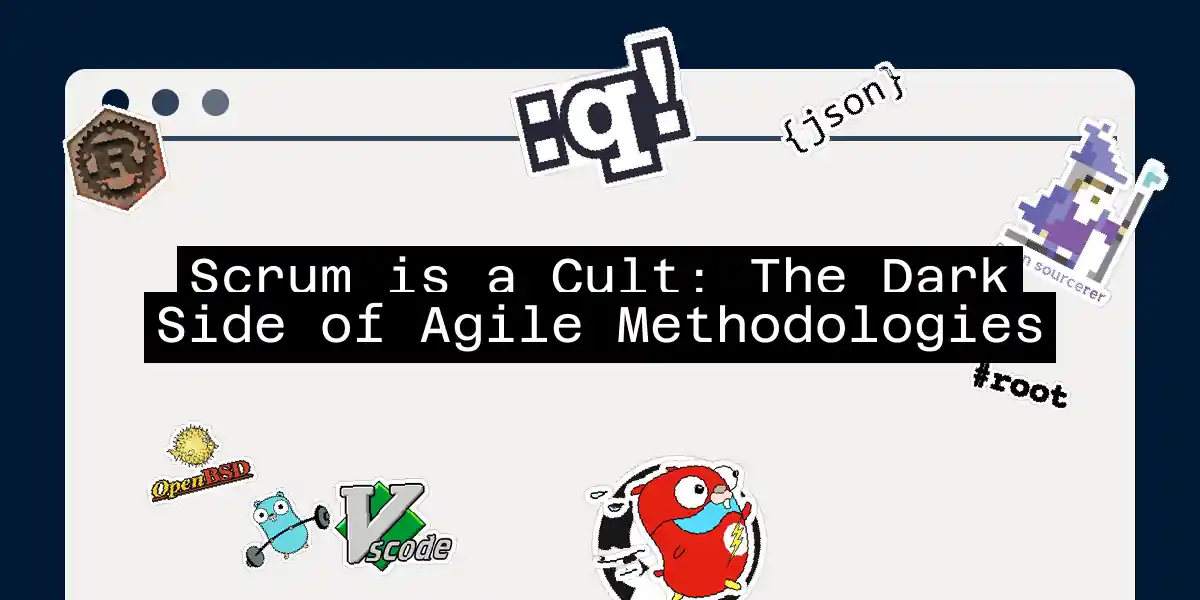The Cult of Scrum: Why Agile Methodologies Can Go Wrong
In the world of software development, few methodologies have sparked as much debate as Agile and its most popular framework, Scrum. While Agile principles aim to foster flexibility, collaboration, and continuous improvement, the reality on the ground often tells a different story. Let’s dive into why Scrum can sometimes feel like a cult, and what this means for your development team.
The Ideology of Agile
Agile, as a philosophy, is built around the Agile Manifesto, which emphasizes individuals and interactions over processes and tools, working software over comprehensive documentation, customer collaboration over contract negotiation, and responding to change over following a plan. These principles are sound and have the potential to revolutionize how we develop software. However, the implementation of these principles, particularly through Scrum, can lead to a rigid and bureaucratic process that stifles creativity and productivity.
The Dark Side of Scrum
1. Over-Reliance on Process
One of the primary criticisms of Scrum is its over-emphasis on process. While Agile is meant to be flexible, Scrum often turns into a rigid framework that prioritizes ceremonies like daily stand-ups, sprint planning, and retrospectives over actual work. This can lead to a situation where developers spend more time in meetings than coding, which is a clear violation of the Agile principle of valuing working software over comprehensive documentation.
2. Micromanagement and Lack of Autonomy
Scrum’s structure, with its defined roles and ceremonies, can sometimes feel like a straitjacket. It often leads to micromanagement, where every task is broken down into epics, stories, and sub-tasks, leaving little room for creativity or self-organization. This is particularly problematic in creative fields where the best work often comes from giving talented individuals the freedom to innovate.
3. Incompetent Leadership
The success of Agile and Scrum heavily depends on the quality of leadership. Good leaders can adapt Agile principles to fit their team’s needs, while bad leaders can turn Scrum into a bureaucratic nightmare. The problem is that many managers who implement Scrum do so without fully understanding its underlying principles or the needs of their team. This can result in a process that is more about ticking boxes than delivering value.
4. Bureaucratic Routines
Scrum’s emphasis on routines can sometimes lead to the emergence of bureaucratic practices that do not add value to the team or the project. For instance, if a team finds that certain ceremonies are not helping them deliver better software, they should be free to drop them. However, in many cases, teams feel compelled to follow the Scrum framework to the letter, even if it means wasting time on unnecessary meetings and planning sessions.
5. Quality Over Process
One of the most significant concerns with Scrum is its potential impact on software quality. When the focus shifts from delivering high-quality software to adhering to a process, the outcome can be subpar. Developers often find themselves rushing to meet sprint deadlines, which can lead to shortcuts and compromises on quality. This is antithetical to the core principles of Agile, which should prioritize working software over rigid adherence to a process.
Real-Life Examples and Anecdotes
The Agency Nightmare
Imagine a digital agency where a new project manager, armed with a few online articles and a Scrum certification, decides to impose Scrum on a team of developers and designers. The result is a team that spends more time in meetings than actually working on the project. This scenario is not uncommon and highlights how Scrum can be misused to the detriment of the team’s morale and productivity.
The Startup Struggle
In a startup environment, the pressure to deliver quickly can lead to a misapplication of Scrum. For instance, a team might move from an iterative process to a more rigid Scrum framework, only to find that it leads to longer project times, defensive estimates, and a higher likelihood of project failures. This is a clear example of how Scrum, when not implemented correctly, can hinder rather than help.
Conclusion: Breaking Free from the Cult
Agile and Scrum are not inherently bad; they are tools that can be incredibly powerful when used correctly. However, when they become dogmatic and rigid, they can stifle the very creativity and flexibility they are meant to foster.
Practical Advice
- Adapt, Don’t Adopt Blindly: Understand the underlying principles of Agile and adapt them to your team’s needs. Don’t implement Scrum just because it’s trendy; make sure it aligns with your project’s goals.
- Focus on Value: Remember that the ultimate goal is to deliver working software. If a ceremony or process is not adding value, it’s okay to drop it.
- Trust Your Team: Give your team the autonomy to self-organize and make decisions. Good leaders empower their teams rather than micromanaging them.
- Customer Involvement: Ensure that customer feedback is integrated into your development process from the beginning. This helps in delivering software that meets the customer’s needs.
By being mindful of these pitfalls and focusing on the true spirit of Agile, you can avoid turning Scrum into a cult-like process that hampers your team’s productivity and creativity. Remember, Agile is a set of guiding principles, not a rigid framework to be followed blindly.
So, the next time you’re tempted to say, “We’re doing Scrum,” take a step back and ask if you’re truly following the principles of Agile or just going through the motions. Your team’s sanity and the quality of your software depend on it.
